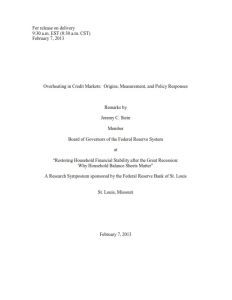Join getAbstract to access the summary!

Join getAbstract to access the summary!
Jeremy C. Stein
Overheating in Credit Markets
Origins, Measurement, and Policy Responses
Federal Reserve Board, 2013
What's inside?
How can regulators ensure that credit markets don’t boil over?
Recommendation
Jeremy C. Stein, a member of the US Federal Reserve Board of Governors, discusses the warning signs of overheating in credit markets. Readers will see why The New York Times calls him the Fed’s “bubble cop.” Stein advocates policies that safeguard the integrity of credit markets but acknowledges that the Fed’s corrective action tools are not infallible. getAbstract recommends his incisive analysis to academics, policy makers and financial services professionals who seek insight on how to identify and handle credit market booms.
Summary
About the Author
Prior to his 2012 appointment to the Fed’s Board of Governors, Jeremy C. Stein was an economics professor at Harvard and a senior adviser to the Obama administration.



















Comment on this summary